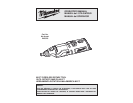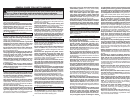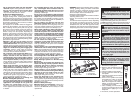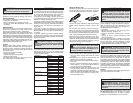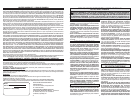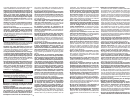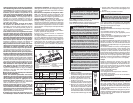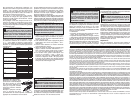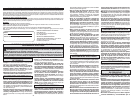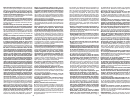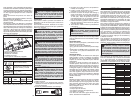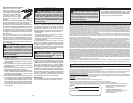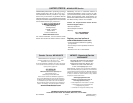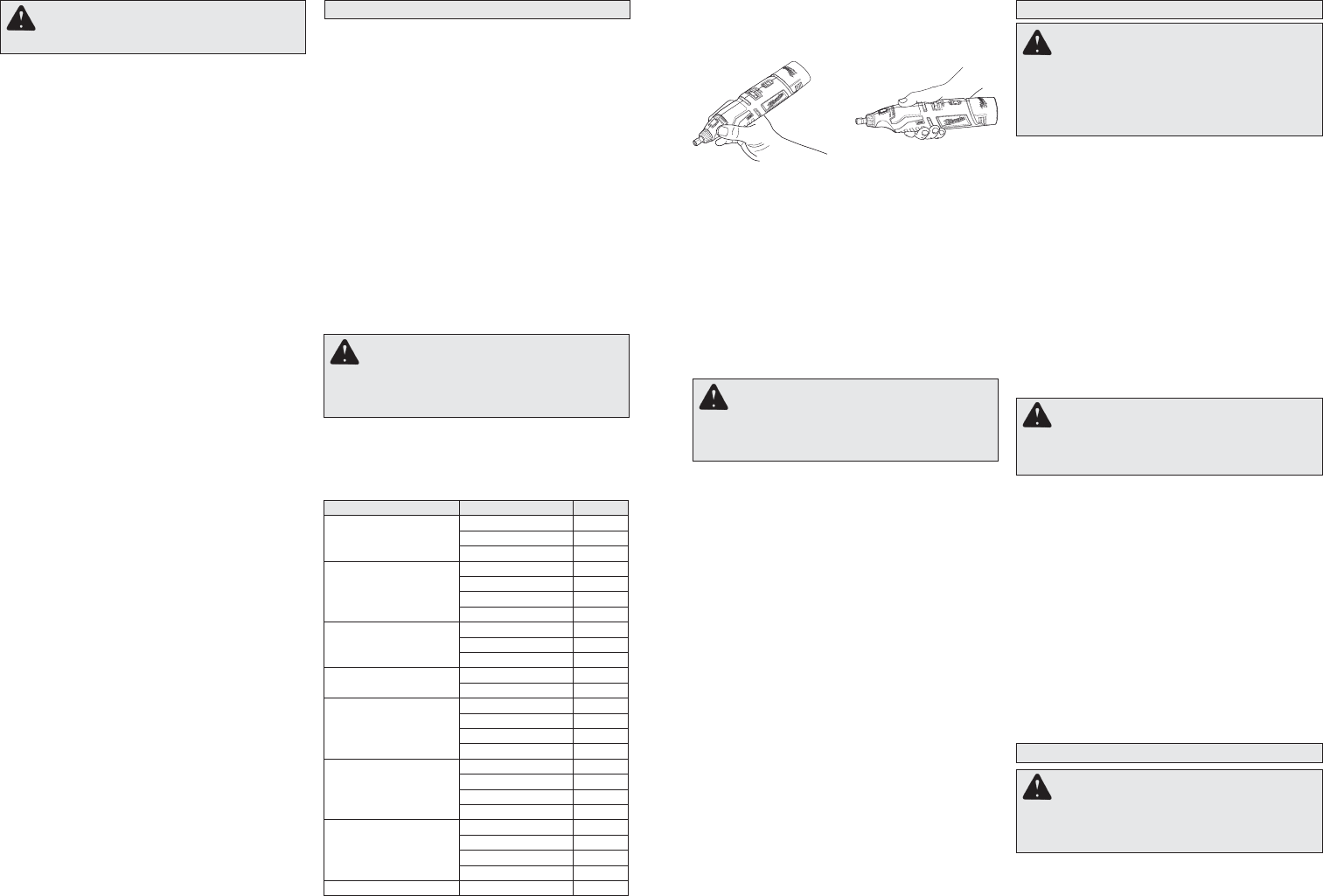
6
7
OPERATION
WARNING Always remove battery
pack before changing or removing ac-
cessories. Only use accessories specifi cally
recommended for this tool. Others may be
hazardous.
Fuel Gauge
To determine the amount of charge left in the bat-
tery, turn the tool ON. The Fuel Gauge will light up
for 2-3 seconds. When less than 10% of charge is
left, 1 light on the fuel gauge will fl ash slowly.
To signal the end of charge, all lights on the fuel
gauge will fl ash quickly for 2-3 seconds and the tool
will not run. Charge the battery pack.
To prevent accidental starting, if the battery pack is
inserted when the tool switch is in the "ON" position,
all lights on the fuel gauge will fl ash twice and the
tool will not run. Turn the tool off, then back on to
begin work.
If the tool or battery becomes too hot, the fuel
gauge lights will fl ash in an alternating pattern and
the tool will not run. Allow the tool and battery to
cool down.
To protect against high torque, binding, stalling,
and short circuit situations, the tool will shut down
and all the fuel gauge lights will fl ash. Release the
trigger and restart.
ACCESSORIES
For a complete listing of accessories refer to your
MILWAUKEE Electric Tool catalog or go online
to www.milwaukeetool.com. To obtain a catalog,
contact your local distributor or service center.
WARNING Always remove battery
pack before changing or removing ac-
cessories. Only use accessories specifi cally
recommended for this tool. Others may be
hazardous.
Maintaining Tool
Keep your tool, battery pack and charger in good re-
pair by adopting a regular maintenance program.
After six months to one year, depending on use,
return the tool, battery pack and charger to a
MILWAUKEE service facility for:
• Lubrication
• Mechanical inspection and cleaning (gears,
spindles, bearings, housing, etc.)
• Electrical inspection (battery pack, charger,
motor)
• Testing to assure proper mechanical and
electrical operation
If the tool does not start or operate at full power
with a fully charged battery pack, clean the contacts
on the battery pack. If the tool still does not work
properly, return the tool, charger and battery pack,
to a MILWAUKEE service facility for repairs.
MAINTENANCE
Cleaning
Clean dust and debris from charger and tool vents.
Keep tool handles clean, dry and free of oil or grease.
Use only mild soap and a damp cloth to clean the
tool, battery pack and charger since certain cleaning
agents and solvents are harmful to plastics and other
insulated parts. Some of these include gasoline,
turpentine, lacquer thinner, paint thinner, chlorinated
cleaning solvents, ammonia and household deter-
gents containing ammonia. Never use fl ammable or
combustible solvents around tools.
Repairs
For repairs, return the tool, battery pack and char-
ger to the nearest service center.
WARNING To reduce the risk of per-
sonal injury and damage, never immerse your
tool, battery pack or charger in liquid or allow
a liquid to fl ow inside them.
WARNING To reduce the risk of injury,
always unplug the charger and remove
the battery pack from the charger or tool
before performing any maintenance. Never
disassemble the tool, battery pack or charger.
Contact a MILWAUKEE service facility for ALL
repairs.
WARNING To reduce the risk of injury,
the operator should be instructed in the
use, care and protection of accessories.
Typical Applications
A large variety of accessories are available for ap-
plications such as grinding, sanding, and cutting.
Grinding/Sanding
Use sanding and grinding accessories that are:
• less than 2" in diameter.
• correct accessory type and grit for the job.
• rated at or above the RPM listed on the tool's
nameplate.
Wheel Brushes
Wire wheel brushes are useful for removing rust,
scale, burrs, weld slag, etc. A wide variety of wire
brushes are available for many applications.
When applying brush to work, avoid using too much
pressure. This causes over-bending of wires and
heat build-up resulting in premature wire breakage,
rapid dulling and reduced brush life. Instead of using
more pressure, try a wire wheel brush with more
aggressive cutting action (increased wire size, de-
creased wire length or different brush type, i.e. knot
type instead of crimped wire type).
Cutting
Always handle cutting wheels carefully to avoid
damage. Before installing any wheel, always in-
spect it for cracks. If wheel is cracked, discard it to
prevent others from using it. Cutting wheels should
be protected from:
• wetness and extreme humidity
• any type of solvent
• extreme changes in temperature
• dropping and bumping
If a cutting wheel encounters any of these situa-
tions, discard the wheel immediately.
Practice on scrap material to determine the best
speed, correct accessory, and get a feel for the
job.
Do not press the accessory into the workpiece.
Little or no operator force should be needed when
the correct accessory and speed are used. Touch
the accessory to the workpiece and guide it over the
work, making muliple passes when necessary.
Move the tool in the same direction as the bit is
spinning (as indicated by the arrow near the front
of the tool). Moving the tool in the opposite direction
can cause the tool to kickback, ending up in loss of
control and damage to the workpiece
Accessory Material Speed
Grinding/Sanding point Wood 2
Steel 3
Aluminum 2
Steel cutters Wood 6
Plastic 2
Steel 2
Aluminum 3
Grinding stone Plastic 2
Steel 6
Aluminum 1
Wire brushes Steel 2
Aluminum 2
Polishing point Wood 1
Plastic 1
Steel 1
Aluminum 1
Cutting wheel Wood 6
Plastic 1
Steel 6
Aluminum 6
Drill bit Wood 6
Plastic 1
Steel 3
Aluminum 3
Router bit Wood 6
Using the Rotary Tool
Determine the best grip for your job. The rotary tool
can be held like a pencil for fi ne work, or gripped
around the body when less precision is needed.
Starting/Stopping
1. Use a clamp, vise or other practical means to
hold your work, freeing both hands to control
your tool.
2. To start the tool, grasp the tool and slide the
switch forward to the ON (I) position.
3. Allow the tool to come to full speed before begin-
ning work.
4. Use the speed control dial to set the maximum
speed. Select "1" for low speed (5000 RPM) up
to "6" for high speed (32000 RPM).
5. To stop the tool, slide the switch back to the
OFF (0) position. Make sure the tool comes to a
complete stop before laying the tool down.
NOTE: Do not press the spindle lock button while
tool is running or the accessory is moving. This
could damage the tool.
WARNING Everyone in the area must
wear protective clothing and safety
goggles or face shields. Damaged acces-
sories may fl y apart with considerable force,
causing potential for serious injury.
Selecting speed
To set the maximum speed, rotate the speed dial.
Set the speed dial to "1" for the lowest speed
(5000 RPM). Set the speed dial to "6" for the high-
est speed (32000 RPM).



